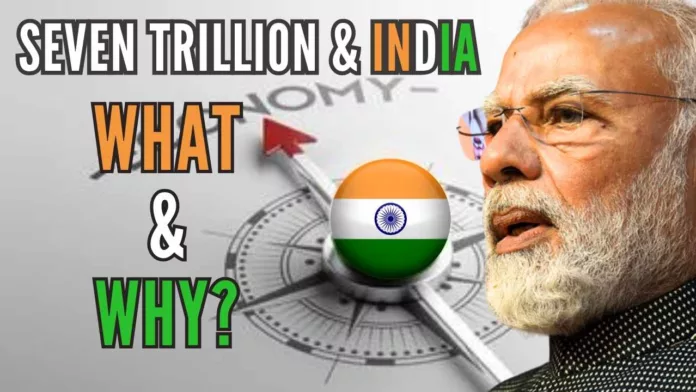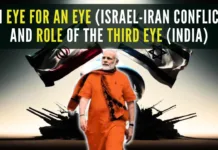
A $7 trillion economy by 2029 with Modi Magic?
Even with a Ph.D. I have to think hard about what seven trillion means. A trillion is one thousand billion and in numbers, it is written as 7,000,000,000,000 (Seven followed by twelve zeros). In India’s system, it will be seventy lakh crores or seventy kharabs (not frequently used anymore). It is unimaginable if anyone, anywhere has seen that much money or that much of anything except in the world of financial markets forecasting companies’ valuation, the GDP of countries, and discussing the world economy.
Why am I writing about it? As I was engaged about Modi’s recent visit to the U.S. and its many positives, I came across a photo of Modi and Biden with the CEOs of three technology giants- Apple, Microsoft, and Google. Modi met many more CEOs (discussed later) and definitely more power to him and his ability to persuade them to FDI in India.
The three technology giants are worth about US $7 trillion (their valuation changes daily) and that made me research whether that number has any contextual meaning with reference to India. Lone behold, I found an article forecasting that India’s economy will reach seven trillion in the next 7 years[1]. What an interesting coincidence and most certainly a welcome change; India’s economy doubling from its current economy of about 3.7 trillion to seven trillion.
Paraphrasing Modi’s address to the joint session of the U.S. Congress, he said that India was the tenth largest economy when he spoke to them in 2016; we are the fifth economy now and India will become the third largest economy “soon.” I wondered what he meant by “soon” but now I know that he was talking about leaving Japan and Germany behind who are ahead of India with about 4.3 to 4.4 trillion economies[2].
There is always a danger in forecasting but the way India’s economy has been rising under Modi’s watch, it should be doable in the next 2-3 years. While I am confident that Modi will be the people’s choice as Prime Minister again in 2024 but the recent efforts for unity among opposition parties, no matter how fractured, should not be underestimated. Nonetheless, Modi back in power in 2024, has the exceptional ability, tenacity, and capability to reach third in the world economy.
The sheer number of trillion also came about in the recent speech by Modi in Madhya Pradesh. In his authentic style of oratory, he first counted the worth of “corruption” by various political parties and said that if you add those up, the corruption money is staggering, worth INR “twenty lakh crores.” It is equivalent to two trillion INR or about U.S. $ 0.25 trillion using an exchange rate of Rs. Eighty per dollar.
Modi also stated openly that if the opposition leaders want to bring back the scandals, he is determined to rid India of corruption to the best of his ability. If the 0.25 trillion economy is running in the parallel underground, it is perhaps not a part of India’s economic projection of seven trillion in 7 years. What Modi says, he says with conviction and uncanny determination. Thus, I am sure that Modi will unearth the corruption money, perhaps most of it stashed away in foreign banks.
Before concluding, I will be remiss not to acknowledge that Modi met more than a dozen CEOs, in addition to the three mentioned above. He spoke to a large contingent of CEOs, Senior Officers of the U.S. government, and Indian counterparts accompanying Modi on his trip[3]. His message was loud and clear that India stands ready for their FDI more than ever before. He invited them to join in the ‘Make in India’ campaign adding that India is equally poised for ‘ Made for the World.’ He assured them about the ‘Ease of Doing Business’ policies in India similar to what he had accomplished in Gujarat as the Chief Minister.
India rising to the third economy from 2016 to 2023, despite two years of the pandemic, is a remarkable and unprecedented achievement of New India under Modi. Barring any natural or pandemic-like calamity, India has the potential to attain a five trillion economy in the next couple of years.
His recent announcement of bringing UCC (Uniform Civil Code) in India has left the opposition in shambles. This makes me believe that Modi Magic is sure to bring him back to power with a stronger mandate followed by a seven trillion economy by 2029, sooner than the projected seven years. Modi’s determination for a corruption-free India is not just a dream but highly realizable during his third term as India’s Prime Minister.
Jai Hind and Jai New Bharat with Sanatan Dharma at its core.
Note:
1. Text in Blue points to additional data on the topic.
2. The views expressed here are those of the author and do not necessarily represent or reflect the views of PGurus.
Reference:
[1] India expected to become $7 trillion economy in seven years: CEA – Jan 12, 2023, ToI
[2] List of countries by GDP (nominal) – Wikipedia
[3] PM Modi meets CEOs on final day of US visit: List of business leaders – Jun 23, 2023, HT
PGurus is now on Telegram. Click here to join our channel and stay updated with all the latest news and views
For all the latest updates, download PGurus App.
- An Eye for an Eye (Israel-Iran conflict) and role of the Third Eye (India) - April 29, 2024
- Education and election in Bharat: Race to the top - April 16, 2024
- Kejriwal: “An Insignificant Man” or a corrupt politician with impending prison term - March 24, 2024











I think it’s important to first look at prominent forecasts in the past to assess fresh ones. In March 2002, the then Indian Ambassador in Washington gave a famous speech.
“”There is that story about the hare and the tortoise,” Lalit Mansingh, India’s experienced and shrewd ambassador to the United States told a meeting at Washington’s University Club this week. He may be right.
China still attracts a colossal $30 billion to $40 billion in foreign investment a year. India only attracts $1.5 billion to $2 billion. There is no question that Indian political and business leaders envy China’s achievement and would like to attract far more. Yet their mid-term economic prospects currently look far better than China’s. How can that be?”
https://www.upi.com/Defense-News/2002/03/29/Analysis-Chinas-hare-Indias-tortoise/72211017412181/
21 years later, China went from having an economy 2.3 times larger than India to 5.3 times. What went so wrong with the past forecast? And are some of the same mistakes being repeated?